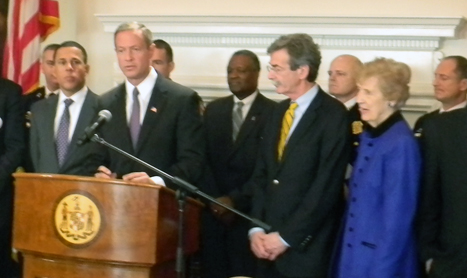Video by Caroline Woodall/CNS-TV
ANNAPOLIS–Gov. Martin O’Malley announced a highly-anticipated gun control and public safety package Friday that would ban the sale of assault weapons, limit the ammunition capacity of magazines and require handgun buyers to submit fingerprints as part of the licensing requirement.
If O’Malley’s proposals become law, prospective gun owners would also have to pass a training course and face more stringent background checks.
Promoting public safety by reducing gun crime and access to certain firearms is the “top legislative priority” this session, O’Malley said during a press conference attended by dozens of legislators, county executives and law enforcement personnel from around the state.
If passed, Maryland’s gun laws will be some of the strictest in the nation.
The majority of the new laws, which Sen. Brian E. Frosh, D-Montgomery, called “courageous and common sense,” are expected to pass swiftly through Maryland’s Democratic-dominated legislature.
However, the stringent new licensing requirements and fingerprinting database are likely to face opposition from both Republicans and more conservative Democrats.
“I think that bill will have probably a difficult time on the floor of the Senate,” Senate President Thomas V. Mike Miller Jr., said Tuesday. “Licensing begins to trample on Second Amendment rights.”
The new legislation will expand upon the Maryland State Police’s list of weapons which are considered assault rifles, said Stacy Mayer, O’Malley’s legislative secretary. While Mayer did not give specifics, she said that for a weapon to be an assault rifle the firearm would “have to be a centerfire rifle, and have to have one or more additional features.”
Additional features on firearms often include pistol grips, collapsible stocks and flash suppressors, amongst others.
The federal assault rifles ban that began in 1994 classified an assault rifle as a semi-automatic rifle with two or more additional features, according to the Coalition to Stop Gun Violence.
Under current Maryland law, citizens over the age of 21 can legally purchase assault rifles as long as the weapons are registered with the Maryland State Police.
The new laws would reduce the maximum ammunition capacity for magazines from 20 rounds to 10.
Also, current law says the ammunition limit does not apply to .22 caliber rifles with magazines that are built into the barrel, rather than detachable. The proposed legislation will also limit those weapons to 10-round capacity magazines, Mayer said.
O’Malley’s assault rifle ban is a “public policy placebo,” said Matthew Daley, vice president of government affairs for the Maryland State Rifle and Pistol Association.
In 2011, handguns, not assault rifles, accounted for nearly two- thirds of every gun homicide nationally, according to a recent FBI report.
“There is no data to show that (assault rifles) are a major part of the firearm violence problem in Maryland,” Daley said.
Regardless of how often assault rifles are used in crimes, “weapons of war” are not used for hunting and have no purpose on Maryland’s streets, said Baltimore County Chief of Police James W. Johnson.
One of the Baltimore County Police Department’s main goals is to “keep excessive firepower out of communities,” Johnson said. “The public is demanding action on this vital issue.”
Banning assault rifles and high-capacity magazines won’t infringe upon the Second Amendment, but it will keep neighborhoods safer, Johnson said.
The proposed laws would also require that gun owners who move to Maryland register their firearm even if those weapons are already registered in the state where the weapon was purchased.
O’Malley’s proposals are not without opponents in the Maryland General Assembly.
“Nothing proposed here will stop bad guys with guns,” said Delegate Michael Smigiel, R-Upper Shore. He went on to call the gun control measures “solutions in search of a problem,” and said his top priority this legislative session will be blocking proposed gun control bills.
Individual members of the state legislature have vowed to introduce their own gun control bills.
Proposals include imposing a 50 percent tax on ammunition, requiring gun owners to purchase insurance and expanding the Maryland State Police’s authority to inspect the inventory of gun sellers.
Gun store inspections are currently performed by the federal Bureau of Alcohol, Tobacco, Firearms and Explosives.
O’Malley’s announcement comes just days after Gov. Anthony Cuomo signed a similar gun control package into law in New York. Cuomo and O’Malley have emerged as possible contenders for the 2016 Democratic presidential nomination.
New York is the first state to pass new gun laws in the wake of the Sandy Hook Elementary shootings in Newtown, Conn.
President Barack Obama announced a series of proposals and executive orders on Wednesday aimed at tightening federal gun control laws.
The president’s plan would reinstate a federal ban on assault weapons that expired in 2004, limit magazine capacity to 10 rounds and close loopholes that allow weapons to be purchased from gun shows and private dealers without a background check.
The orders also aim to increase the legal penalties for “straw purchasers,” individuals who purchase guns on behalf of criminals.
O’Malley stressed the importance of investing in Maryland’s mental health treatment facilities, as well as an increased emphasis on early detection of potential violent mental disorders.
While O’Malley doesn’t “think equipping teachers with Uzis and gun belts is the answer,” he called for increased cooperation between local law enforcement agencies and educators to develop policies and procedures to reduce violence in schools.
“There is no way to completely eliminate the threat and the risk of another tragedy like Newtown,” O’Malley said. “But there might be actions we can take to prevent that from happening.”

